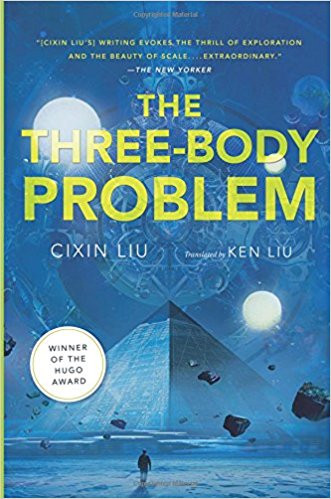I bought this book and made it halfway through before I realized it was part of a trilogy. I rarely have the patience for trilogies anymore so I tend to avoid them, but now I’m locked in for another two books so this should be interesting! Hah! Hopefully this turns out better than the time I attempted to review more than one Horus Heresy novel in a row.
Cixin Liu’s The Three-Body Problem is a Hugo-Award-winning book that was on the “staff picks” shelf in Powell’s when I was in Portland back in November. It’s an Obviously Good ™ book, so I’ll admit I went in prepared to sing its praises.
Not that I’m disappointed, it certainly is good. I found that for a number of reasons the pacing of the novel tended to ebb and flow for me. There were bits where I devoured entire chapters, unable to put it down, and bits where it took me several days to make it through 10 pages.
Liu plants an extraterrestrial first-contact tale deeply in the mire of contemporary Chinese history. I’ll admit that my knowledge of the Cultural Revolution is vague at best, and the novel starts by presenting a not-entirely-objective interpretation of events so I still can’t call myself an expert. Liu’s focus lies with the impact of the revolution on academia and scientific research, particularly in the field of theoretical physics.
In Liu’s fiction, the events of the Cultural Revolution indirectly set in motion an extraterrestrial invasion of Earth by fostering a disdain and mistrust for humanity in the best and brightest of astronomers, physicists, and military personnel.
First contact reveals itself slowly as characters in two different timelines play their separate parts. Ye Wenjie, an astrophysicist who is sent to work at a military base using radio scanning equipment for tactical purposes during the revolution, discovers a novel method of amplifying radio waves, allowing a later transmission to be sent into another solar system.
Decades after this discovery, Wang Miao, a present-day nanomaterials researcher, stumbles upon a bizarre VR game in which players are unknowingly introduced to the aliens that Ye Wenjie opened communications with decades before, by attempting to solve a physics problem that plagues the in-game NPCs.
The aliens are called Trisolarans, as they inhabit a planet caught in the unpredictable orbit of three stars. These three stars (the three bodies identified in the book’s title) cause the planet to oscillate violently between periods of extreme cold, incinerating heat, and occasionally, an era of mild and predictable temperatures known by locals as a “stable era.”
The communication that Ye Wenjie opens causes a cascade of events leading to a sort of multi-tiered invasion, the first phase of which manifests in the individual minds of high-level physicists, and which is designed to culminate in a physical invasion some four centuries in Earth’s future. Humanity must coordinate and plan ahead on a scale never before imagined, or doom a distant future generation to certain death.
Phrased that way it seems like an apt metaphor for the climate change issues of today, but rest assured that I’m oversimplifying it.
Throughout the novel, Liu does an incredible job of evoking complex processes on magnitudes both extremely large and extremely small, using clever metaphor and visualization. The basic binary function of a computer, for example, is at one point depicted with thousands of pairs of soldiers raising and lowering alternating flags. In another scene, the unfolding of a photon into additional dimensions is described in beautiful visual detail, and reminded me of some of the more fascinating descriptions of life in six dimensional spaces, in Greg Egan’s Diaspora.
The aliens themselves are interestingly thought out – with characteristics that would be plausible for their extreme environment, as well as others that seem deliberately designed to reflect the worst aspects of human nature back at the reader. While the scope of the novel is massive – in some cases too massive to easily relate to – I appreciated that it did not extend all the way to preemptively describing the physical appearance of the Trisolarans. They remain enticingly alien through the very end of the book.
I’ve started reading The Dark Forest at this point already and it so far holds to the same level of scope, in which the story spans the entire globe, yet will occasionally stop to focus intently on the tiniest minutiae of Earth, or spend pages on the inner thoughts of a single character. It’s an interesting strategy, one that allows for a large number of threads to eventually come together, even if they take their sweet time getting there.
Pick up this book if you want to contemplate the destruction of the human race as a psychological, rather than a physical process. Read it if you want to feel small, or to lament the heartbreaking shortness of the human lifespan – and the daunting idea of continuing to operate as a unit despite the routine death and replacement of every aspect of a system.

One thought on “The Three-Body Problem by Cixin Liu”